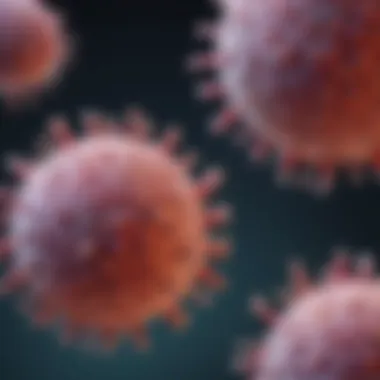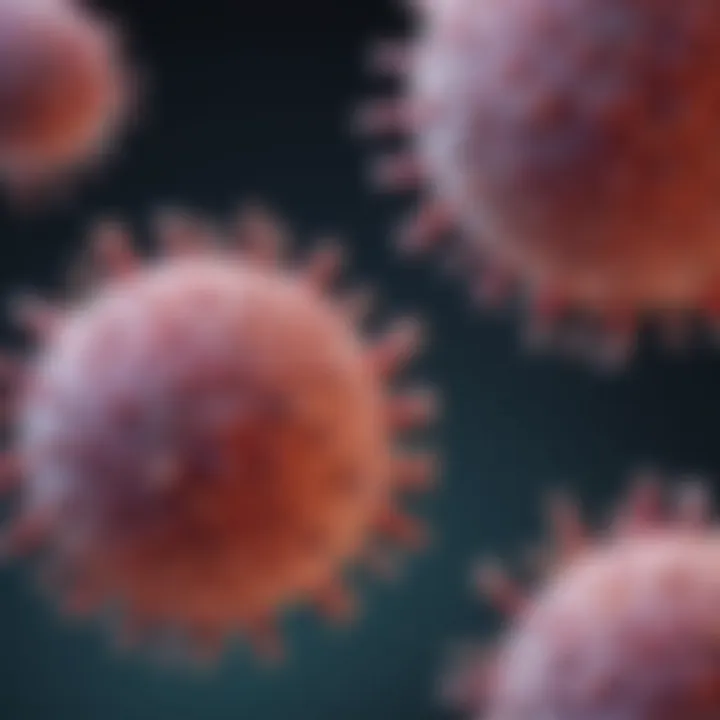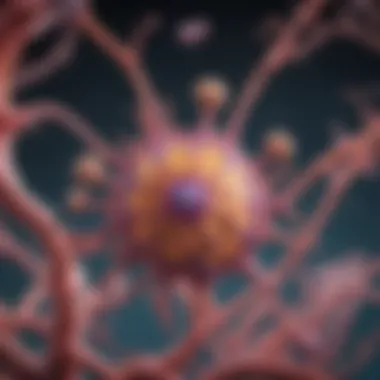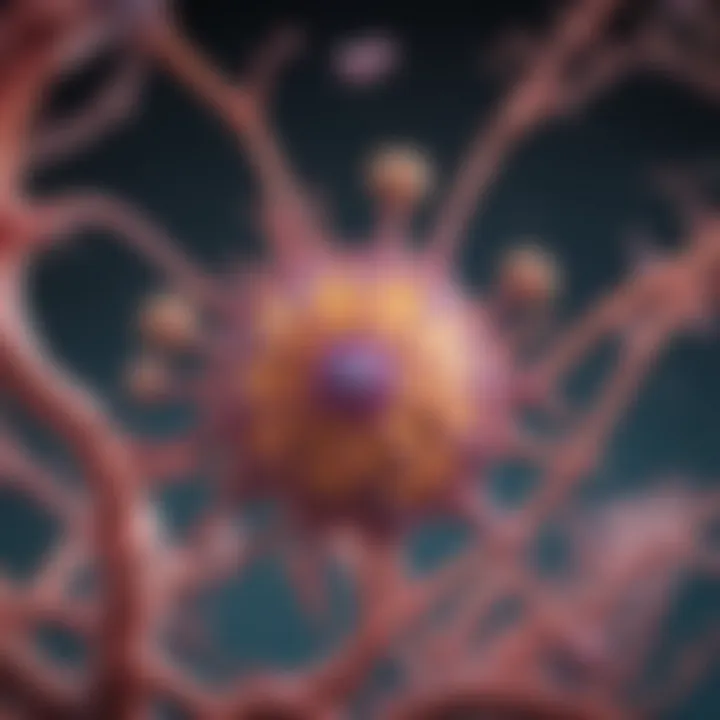Understanding KIT Gene Mastocytosis: Insights and Implications


Intro
Mastocytosis entails a complex condition that affects a small subset of the population. It involves the excessive accumulation of mast cells in tissues, often due to mutations within the KIT gene. This condition can manifest in various forms, ranging from cutaneous mastocytosis, which is more superficial and visible on the skin, to systemic mastocytosis, affecting internal organs. Understanding the genetic mechanisms that underlie mastocytosis, particularly those influenced by the KIT gene, is crucial for effective diagnosis and treatment.
The KIT gene plays an essential role in the development and survival of mast cells, which are pivotal components of the immune system. Mutations in this gene disrupt normal mast cell regulation, leading to the clinical symptoms observed in individuals suffering from mastocytosis. The significance of exploring these genetic mutations lies in the potential for developing targeted therapies that can specifically address the underlying causes of the disease.
In the following sections, this article will examine the methodologies used in current research surrounding mastocytosis, followed by future directions that could shape ongoing inquiries into the KIT gene mutations. The aim is to furnish students, researchers, and healthcare professionals with a thorough understanding of the genetic and clinical landscape of mastocytosis, thereby enhancing the efficacy of patient care and treatment regimens.
Preface to Mastocytosis
Mastocytosis is a complex condition that presents significant challenges for both patients and healthcare professionals. Understanding this disease is crucial because it involves the abnormal accumulation of mast cells in various tissues. These cells play a vital role in the immune system, yet their excessive presence can lead to various health issues. This section will provide a deep dive into the concepts surrounding mastocytosis, including its definition and historical background.
Definition and Overview
Mastocytosis is defined as a disorder characterized by an abnormal increase in mast cells. These cells are primarily involved in allergy and immune responses. The condition can manifest in different forms, ranging from mild skin irritations to severe systemic symptoms impacting multiple organs. The classification includes cutaneous mastocytosis, which affects the skin, and systemic mastocytosis, where internal organs are involved. Understanding the specifics of mastocytosis is essential for accurate diagnosis and effective management, particularly in light of its association with mutations in the KIT gene, which plays a critical role in mast cell development and function.
Historical Context of Mastocytosis Research
The research on mastocytosis has evolved significantly over the years. Initially recognized in the early 20th century, the understanding of the disease has grown from mere observation to encompassing genetic insights. Early studies focused primarily on the clinical aspects and morphology of mast cells. However, the discovery of the KIT gene as a key player in mastocytosis opened new avenues for investigation. Researchers began to explore the genetic mutations associated with the condition, leading to a better understanding of its pathology and potential treatment avenues. This historical context underscores the importance of continued research, as every advancement builds upon previous knowledge, allowing for better clinical outcomes and patient care.
"The evolution of mastocytosis research reflects the broader trends in medical science: a shift from descriptive studies to molecular genetics, aiming for comprehensive understandings of disease mechanisms."
As we delve further into this article, we will illuminate not only the genetic underpinnings of mastocytosis but also the practical implications of this knowledge for diagnosis and treatment.
The Role of the KIT Gene
The KIT gene plays a pivotal role in mastocytosis as it is intricately linked to the proliferation and survival of mast cells. Understanding this gene is crucial for comprehending the underlying mechanisms of mastocytosis. Mutations in the KIT gene are a primary driver of this rare condition, and they lead to abnormal mast cell behavior. These abnormalities result in excessive accumulation of mast cells in various tissues, which can cause a range of symptoms and complications.
Research into the KIT gene provides invaluable insights into the pathophysiology of mastocytosis. By delving into its functions and mutations, researchers can develop targeted therapies that may improve patient outcomes. The focus on the KIT gene also helps unify various presentations of mastocytosis under a common genetic framework, offering a more coherent understanding of the disease. Thus, the role of the KIT gene is not only central to recognizing the condition but is also crucial for innovating treatment approaches.
Function of the KIT Gene
The KIT gene encodes for a receptor tyrosine kinase, which is essential for several cell signaling pathways. This gene is integral to hematopoiesis, the process of blood cell formation, and mast cell development. When the KIT receptor is activated by its ligand, stem cell factor, it triggers signals that promote cell survival, proliferation, and differentiation into mast cells. This process is vital for normal immune function.
In mastocytosis, mutations in the KIT gene disrupt these mechanisms. Some mutations lead to constitutive activation of the KIT receptor, causing mast cells to proliferate uncontrollably. This overactivation can result in inappropriate responses to environmental triggers, contributing to the diverse symptoms observed in patients with mastocytosis.
The identification of specific KIT mutations has significant implications for targeted therapy. By understanding which mutations are present, clinicians can tailor treatments to inhibit the aberrant signaling pathways activated by the KIT receptor. This approach highlights the importance of genetic insights in administering effective treatments for mastocytosis.
Mutations Associated with Mastocytosis
Mutations in the KIT gene are the hallmark of mastocytosis, and they can occur in different forms. The most common mutations involve point mutations in specific codons, such as codon 816. These mutations lead to the replacement of amino acids in the KIT protein, which ultimately alters its regulatory behavior.
Key Aspects of KIT Mutations:
- Type of Mutations: The most frequently observed mutations in mastocytosis include D816V, which occurs in both systemic and cutaneous forms of the disease. Other mutations can also be present, though less commonly.
- Mutation Context: The presence of mutations may vary according to the type of mastocytosis. Systemic mastocytosis typically shows a higher prevalence of KIT mutations compared to cutaneous forms.
- Implications for Treatment: Understanding the specific mutations can guide treatment options. For instance, certain targeted therapies, like imatinib, may be more effective for some mutations than others.
"Identifying the specific KIT mutations not only improves diagnostic accuracy but also significantly influences treatment strategies."
Overall, elucidating the nature and role of KIT mutations allows for more personalized management strategies in mastocytosis, potentially leading to improved therapeutic outcomes and patient quality of life.
Types of Mastocytosis
Understanding the various types of mastocytosis assists in recognizing its manifestations and implications. Each type has distinct characteristics that can significantly affect diagnosis and treatment plans. Proper categorization enables healthcare providers to tailor management strategies more effectively and informs both patients and researchers about the specific challenges associated with each variant.
Cutaneous Mastocytosis


Cutaneous mastocytosis is typically characterized by a localized increase in mast cells in the skin. It is more common in children, often presenting with urticaria pigmentosa, which manifests as brownish spots or papules that may itch or burn when rubbed. These lesions often indicate a mast cell accumulation in the epidermis.
Diagnosis can usually be made through clinical examination, alongside a skin biopsy to confirm mast cell proliferation. Most patients with cutaneous mastocytosis may have a favorable prognosis, as many cases resolve spontaneously over time. This variant’s management focuses on symptomatic relief, especially when pruritus is present. Topical treatments like corticosteroids and antihistamines are commonly used, although responses may vary.
Systemic Mastocytosis
Systemic mastocytosis involves a more pronounced mast cell proliferation affecting more than just the skin. This type can involve organs such as the liver, spleen, and bone marrow. Symptoms may include gastrointestinal problems, bone pain, and symptoms related to anaphylaxis, making it considerably more complex than its cutaneous counterpart.
The diagnosis of systemic mastocytosis usually requires a bone marrow biopsy and additional serological tests to check for elevated tryptase levels, a biomarker for mast cell activation. The management of systemic mastocytosis may include the use of ** and antihistamines** to control symptoms, alongside newer targeted therapies such as imatinib for cases involving specific mutations in the KIT gene. The prognosis can vary widely among patients based on the extent of organ involvement, highlighting the need for individualized treatment plans.
Other Variants of Mastocytosis
In addition to cutaneous and systemic forms, there are other variants of mastocytosis that deserve attention. These include
- Solitary mastocytoma, which usually appears as a single lesion, often found in children.
- Mast cell sarcoma, a rare and aggressive variant that requires immediate and rigorous treatment due to its potential for systemic spread.
These variants may sometimes share symptoms with more common forms but often necessitate unique diagnostic approaches and treatment protocols. Early identification and intervention can be crucial for improving outcomes, particularly for aggressive forms of mastocytosis. As research progresses, better insights into these variants may lead to improved management strategies and hopefully enhanced patient quality of life.
Clinical Presentation of Mastocytosis
The clinical presentation of mastocytosis is crucial for diagnosing and managing this complex condition. Understanding the symptoms and signs is essential for healthcare professionals and researchers alike, as it plays a vital role in differentiating mastocytosis from other conditions with similar manifestations. Accurate identification of clinical features leads to appropriate treatment strategies, improving patient outcomes.
Common Symptoms and Signs
Mastocytosis can present a wide range of symptoms, influenced by the number of mast cells accumulated in the body. Some of the most frequent symptoms include:
- Flushing: A sudden reddening of the skin, particularly on the face and neck. This can be triggered by emotional stress, exercise, or certain foods.
- Itching and Rash: Patients may experience itchy skin, hives, or rashes due to the release of histamine from mast cells.
- Abdominal Symptoms: Nausea, vomiting, and diarrhea are common digestive issues affecting individuals. These gastrointestinal symptoms often result from mast cell degranulation.
- Anaphylactic Reactions: In severe cases, patients are at risk of anaphylaxis, a life-threatening allergic reaction that can include difficulty breathing, swelling, or loss of consciousness.
"Recognizing the clinical signs of mastocytosis is crucial for preventing severe reactions and providing timely treatment."
Patients often report that symptoms can vary greatly in intensity and frequency. Some individuals have chronic symptoms, while others may experience acute episodes. This variability poses challenges for diagnosis and underscores the necessity for thorough clinical evaluation.
Systemic Involvement
Systemic mastocytosis can lead to more severe and widespread symptoms, reflecting the extensive involvement of mast cells in various organs. Key aspects of systemic involvement include:
- Bone Pain: Many patients experience bone pain due to mast cell accumulation in the bone marrow, which may mimic other hematological conditions.
- Liver and Spleen Enlargement: Hepatomegaly and splenomegaly can occur, leading to complications and further symptoms, such as abdominal pain and increased vulnerability to infections.
- Cardiovascular Issues: Elevated levels of mast cells can affect the cardiovascular system. Patients may develop hypotension or experience tachycardia, which requires careful management to prevent exacerbation of symptoms.
- Potential for Malignancy: In some cases, systemic mastocytosis can evolve into a more aggressive form, leading to mast cell leukemia. Continuous monitoring for these developments is important.
Understanding the systemic implications of mastocytosis helps clinicians assess the severity of the disease and design appropriate treatment and management plans. This insight can ultimately enhance patient care and support ongoing medical research.
Diagnostic Approaches
The diagnostic approaches for mastocytosis are critical for accurate identification and management of the condition. Proper diagnosis involves multiple levels of evaluation to ensure that patients receive appropriate treatment. The integration of clinical history, laboratory tests, and genetic testing forms a comprehensive diagnostic strategy. Understanding these elements allows healthcare professionals to distinguish mastocytosis from other similar conditions effectively.
Clinical Evaluation and History
The clinical evaluation is the first step in diagnosing mastocytosis. Healthcare providers gather detailed patient history, focusing on symptoms and personal or family medical histories. Mastocytosis may present with a variety of symptoms, including flushing, itching, abdominal pain, and anaphylaxis.
"A thorough patient history often uncovers pivotal details that guide the diagnostic process."
Examining these symptoms in conjunction with family history may reveal patterns that suggest a genetic predisposition to mast cell disorders. Furthermore, a physical examination may identify visible signs, such as skin lesions or changes associated with systemic involvement. These findings significantly contribute to guiding the next steps in diagnosis.
Laboratory Tests for Diagnosis
Laboratory tests play a vital role in confirming mastocytosis. A variety of blood tests are commonly employed, primarily focusing on tryptase levels. Elevated serum tryptase indicates increased mast cell activity, which is suggestive of mastocytosis.


Additional tests may include:
- Complete blood count (CBC) to assess overall health and detect potential associated conditions.
- Blood chemistry tests to evaluate organ function, which helps identify systemic mastocytosis.
- Bone marrow biopsy, which provides definitive evidence of mast cell proliferation, especially in systemic cases.
These tests help differentiate mastocytosis from other similar disorders and are often considered essential for a conclusive diagnosis.
Genetic Testing for KIT Mutations
The final pillar in the diagnostic approach is genetic testing, particularly for mutations in the KIT gene. This gene is crucial for mast cell growth and survival, and mutations often drive the pathogenesis of mastocytosis. Genetic testing can confirm the presence of these mutations, which is especially important for identifying forms of the disease that may respond to targeted therapies.
With the advancement of genetic technology, non-invasive methods like liquid biopsies are becoming more common. These tests allow for the analysis of circulating tumor DNA, which can provide insights into the presence of mastocytosis without the need for more invasive procedures.
Management and Treatment Options
Management and treatment options are crucial considerations in the context of mastocytosis, particularly with respect to the KIT gene mutations that often drive the condition. Understanding how to manage mastocytosis effectively can enhance the quality of life for patients and mitigate potential risks. This section will provide a detailed examination of available pharmacological and non-pharmacological management strategies.
Pharmacological Interventions
Pharmacological interventions play a significant role in the treatment of mastocytosis. The primary goal here is to control symptoms and prevent mast cell activation. Antihistamines are commonly used as first-line treatments to address symptoms like itching, hives, and gastrointestinal discomfort. Both and blockers can offer relief by blocking the action of histamine.
- Specific medications include:
- Cetirizine – effective for allergic symptoms.
- Ranitidine – used for gastric acid secretion control.
Additionally, patients with more severe forms of systemic mastocytosis might require treatments such as corticosteroids to reduce inflammation and immunosuppressants to modulate the immune response. Another class of drugs, known as mast cell stabilizers, can further help in preventing mast cell degranulation.
Despite the benefits of these treatments, it is important to consider potential side effects and their interactions with other medications. Monitoring is advised to adapt treatment as necessary.
Non-Pharmacological Management
Non-pharmacological management involves various approaches that can complement pharmacological treatment. This aspect of care focuses on lifestyle changes and alternative therapies that can help ease symptoms.
- Avoidance Strategies:
- Dietary Modifications:
- Patient Education:
- Stress Management Techniques:
- Identifying and avoiding triggers is paramount. Common triggers may include certain foods, temperatures, and environmental factors. Keeping a diary to log symptoms and potential triggers can aid in this process.
- Some patients report improvement in symptoms through dietary changes. A low-histamine diet eliminates foods high in histamine, such as aged cheeses, processed meats, and alcohol.
- Educating patients about their condition is essential. Knowledge about mastocytosis and how to manage reactions effectively can empower patients. Support groups can provide an invaluable resource for emotional support and shared experiences.
- Techniques like mindfulness, yoga, and meditation can help reduce stress, which may be a trigger for mast cell activation.
Ultimately, an integrated approach that combines both pharmacological and non-pharmacological methods tends to yield the best outcomes. Each patient's management plan must be tailored to their individual needs, considering the complexity and variability of mastocytosis.
Prognosis and Outcomes
Prognosis and outcomes in mastocytosis provide a crucial understanding of the disease's trajectory and its implications for treatment. These aspects not only highlight the complexity of mastocytosis but also shape the approach clinicians take in managing the condition. Prognosis is influenced by various factors, including the type of mastocytosis, the patient's age, and the presence of specific KIT mutations. Understanding these variables helps in assessing risks and developing tailored treatment plans.
Factors influencing prognosis play a significant role in both clinical management and patient counseling. For instance, individuals with systemic mastocytosis typically have a more variable prognosis compared to those with cutaneous mastocytosis. Moreover, the degree of mast cell infiltration in various organs may indicate the potential for severe manifestations. Of particular note is the correlation between certain KIT mutations and disease severity. An examination of these mutations can provide insights into expected outcomes and guide follow-up care.
In terms of patient management, effective communication of prognostic information is essential. Patients need to be made aware of what they might expect over time. Understanding prognosis can empower patients to engage in their own care actively.
Factors Influencing Prognosis
Several factors used to evaluate the prognosis of mastocytosis include:


- Type of Mastocytosis: Cutaneous subtypes generally have a better prognosis compared to systemic forms. Systemic mastocytosis may lead to complications and more severe symptoms.
- Age at Diagnosis: Younger patients often experience a slower disease progression compared to older patients.
- KIT Mutations: Specific mutations, such as those affecting codon 816, are associated with a more aggressive disease course. Knowing the mutation can help predict the disease trajectory.
- Comorbid Conditions: The presence of other health issues can complicate treatment and lower overall prognosis.
These factors highlight the importance of personalized assessments in predicting outcomes for individuals with mastocytosis.
Survival Rates and Long-Term Management
Survival rates for patients with mastocytosis vary considerably, influenced by the factors mentioned earlier. Data indicate that patients with indolent systemic mastocytosis often have a good long-term outlook. In contrast, aggressive systemic mastocytosis tends to have a much lower survival rate. While precise statistics may vary, current estimates indicate a significantly higher risk of mortality associated with forms of the disease characterized by more severe systemic involvement.
Long-term management of mastocytosis should involve multidisciplinary approaches. Patients generally require ongoing monitoring to track any changes in symptoms or disease status. Regular evaluations enable timely interventions, which may improve outcomes.
Effective management can also include:
- Regular Follow-Up: Consistent visits with healthcare providers help to assess disease progress and treatment efficacy.
- Patient Education: Ensuring that patients understand their condition and potential symptoms of mast cell activation is vital.
- Psychosocial Support: Addressing mental and emotional health is important to enhance quality of life and adherence to treatment plans.
Understanding prognosis and outcomes in mastocytosis is essential for both clinicians and patients, guiding treatment decisions, and improving long-term health.
Overall, monitoring prognosis and outcomes plays an integral role in shaping management strategies for mastocytosis, allowing for a proactive approach to patient care.
Current Research and Future Directions
Mastocytosis is an area of active research, influenced heavily by the genetic aspects tied to the KIT gene. Researchers are exploring novel treatments and the efficacy of existing therapies at an unprecedented pace. Understanding the implications of ongoing studies can provide clarity and hope to patients and their healthcare providers.
Emerging Treatments and Clinical Trials
The emergence of targeted therapies represents a significant advancement in mastocytosis treatment. Clinical trials are evaluating a variety of small-molecule inhibitors aimed at specifically addressing KIT mutations. These therapies include drugs like avapritinib and midostaurin, which selectively inhibit the mutated forms of the KIT protein.
Key aspects of these trials are:
- Patient Selection: Trials are keen to identify the right cohorts, focusing on patients with identified mutations in their KIT gene.
- Efficacy Measurement: Researchers analyze how well these treatments control symptoms and reduce mast cell burden.
- Side Effects Management: Side effects are monitored closely, ensuring that any adverse reactions can be managed promptly.
The results thus far have shown promise in increasing progression-free survival rates among patients. This progression highlights the potential shift in treatment paradigms, moving from broad-spectrum medications to more tailored therapeutic approaches.
Ongoing Research Gaps
Despite advances, several gaps in research remain that need addressing. These gaps can hinder the progress towards effective treatment options and better patient outcomes. Some of these are:
- Long-Term Efficacy Studies: There is a need for more comprehensive studies on the long-term effects of newer treatments. Understanding how patients respond over extended periods can inform better management strategies.
- Patient Diversity: Much of the existing research does not encompass a diverse patient population. Different genetic backgrounds can lead to varied responses to treatment.
- Comorbidities Exploration: Many patients have co-existing medical conditions that complicate treatment. Research fails to address how these conditions interact with mastocytosis and its treatment.
Further emphasis on these areas will lead to a more nuanced understanding of mastocytosis and improve patient care living with this condition.
"Addressing existing gaps in research not only benefits scientists but can drastically improve the quality of life for patients."
The landscape of mastocytosis research is evolving. As new techniques and understanding emerge, the importance of KIT gene research continues to underpin therapeutic innovation. Continuous efforts in these areas are crucial for enhancing treatment efficacy and overall patient outcomes.
Culmination
The conclusion of this article encapsulates the intricate relationship between the KIT gene and mastocytosis, emphasizing its significance not only in understanding the disease but also in shaping treatment and research approaches. This analysis has illuminated several key elements that are paramount in managing mastocytosis and advancing scientific inquiry.
Summary of Key Insights
The insights presented throughout this article underscore the multifaceted nature of mastocytosis. The KIT gene stands at the central pivot, driving many of the genetic mutations that result in this condition. Here are several core points:
- KIT Gene Mutations: Understanding the role of these mutations allows for more precise diagnostics and personalized treatment regimens tailored to individual patients.
- Clinical Symptoms: Recognizing the range of symptoms—from cutaneous manifestations to systemic involvement—facilitates timely and accurate diagnoses, critical for effective management of the disease.
- Research Innovations: Ongoing studies focusing on emerging treatments and clinical trials are essential for developing new therapeutic options.
- Holistic Management: Both pharmacological and non-pharmacological management strategies play vital roles in improving patient quality of life and disease outcomes.
"A thorough grasp of the genetic and clinical attributes of mastocytosis is crucial for enhancing patient care and informing future research avenues."
Implications for Practice and Research
The implications of the insights gained extend deeply into clinical practices and research frameworks:
- Enhanced Patient Care: With a clear understanding of the KIT gene's impact on mastocytosis, healthcare providers can offer more targeted therapies, improving patient responses and management outcomes.
- Need for Continued Research: The landscape of mastocytosis treatment is evolving. Future research must aim to bridge the gaps in our current understanding, focusing on the long-term effects of novel therapies and the psychosocial impacts on patients.
- Education and Awareness: Increasing awareness among healthcare professionals about the implications of KIT mutations can lead to better diagnostic practices and treatment pathways.
- Collaboration: Collaborative efforts between researchers, clinicians, and patients can foster advancements in personalized medicine, ultimately benefiting the mastocytosis community.
In summary, this article not only contributes to the current body of knowledge on mastocytosis and the KIT gene but also paves the way for future discoveries that will undoubtedly enhance patient care and inform clinical practices.







